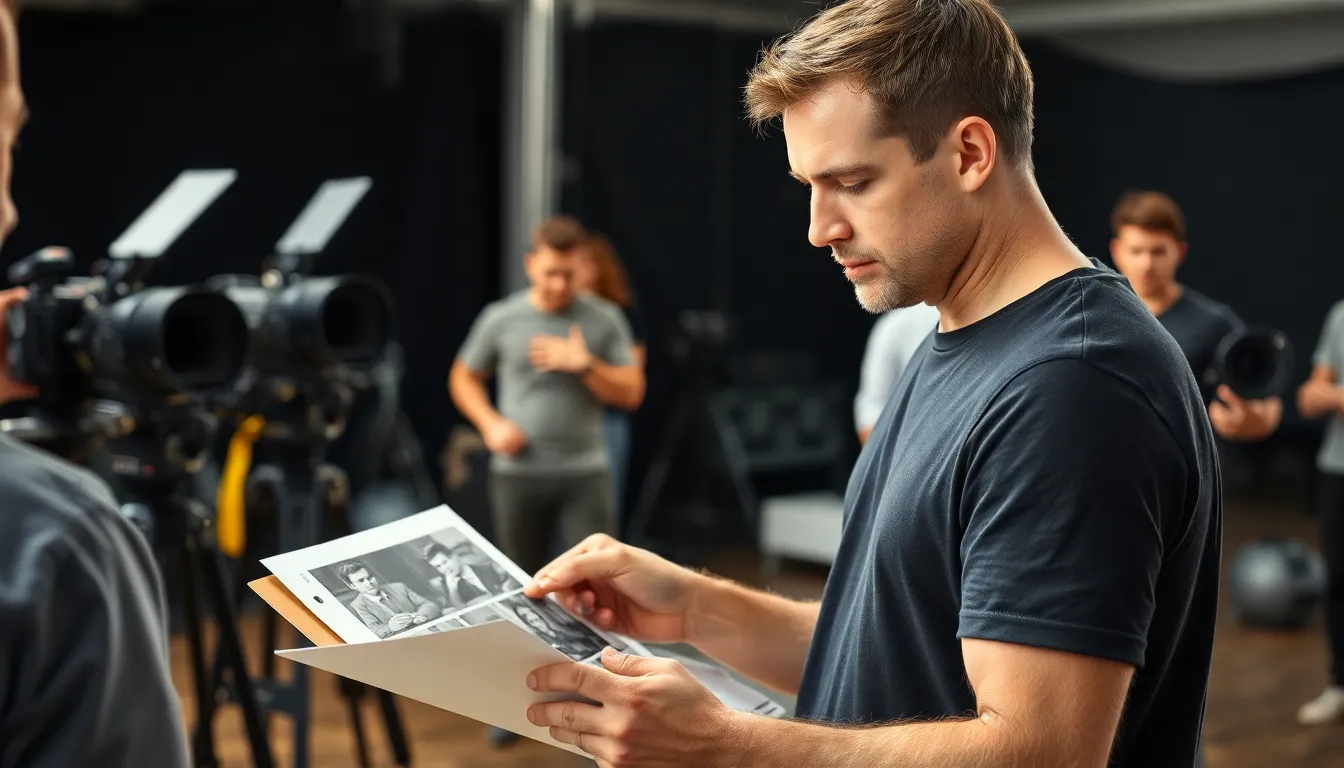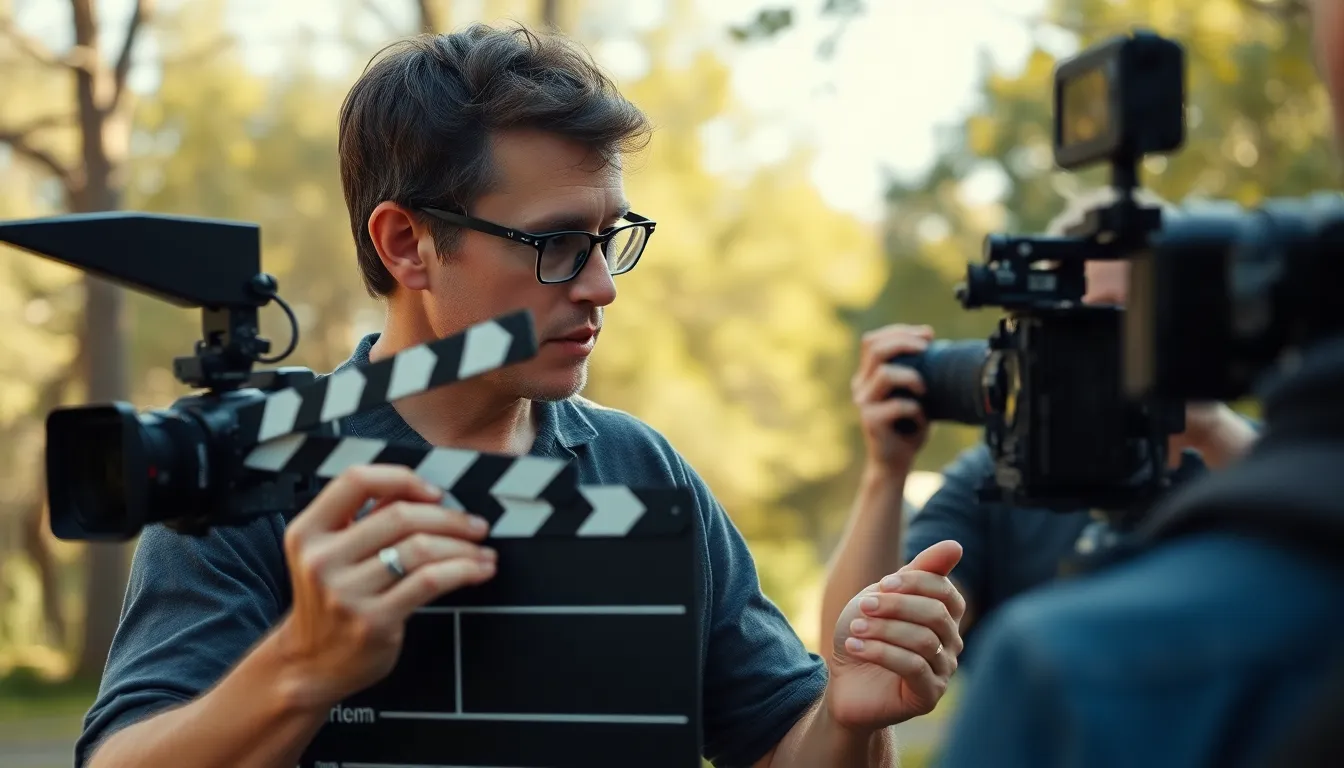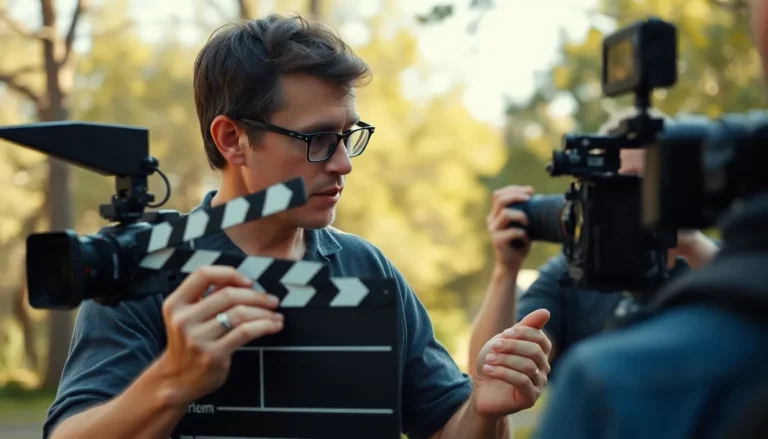Lights, camera, action! Ever wondered what goes on behind the scenes of your favorite films? Film directors are the unsung heroes, juggling creativity and chaos while crafting the stories that captivate audiences. From the initial script to the final cut, their insights reveal the magic and madness of filmmaking.
Imagine trying to herd cats while blindfolded—now add a camera and a budget. Directors navigate this wild terrain with finesse, turning visions into reality. They’re not just calling the shots; they’re orchestrating an entire symphony of talent, technology, and tenacity.
In this article, we’ll dive into the minds of these cinematic wizards, uncovering their secrets, challenges, and perhaps a few laughs along the way. Get ready to explore the art of directing and discover what truly makes a film unforgettable.
Table of Contents
ToggleUnderstanding Film Director Insights
Film directors play an essential role in shaping a film’s narrative and aesthetic. Through collaboration with various departments, they transform scripts into visual stories. Creative decisions often hinge on interpreting a screenplay’s thematic elements and translating them to the screen.
Notably, directors balance artistic vision with practical limitations. Budget constraints significantly influence choices regarding locations, casting, and special effects. Managing these factors requires a keen understanding of both the art and business sides of filmmaking.
Directing involves a continuous dialogue with actors and crew members. Effective communication fosters an environment where creativity flourishes. Feedback loops facilitate adjustments and lead to stronger performances from actors.
Moreover, insights from seasoned directors reveal diverse inspirations. Some draw from life experiences, books, or art forms, while others cite specific films that shaped their perspective. These influences contribute to unique storytelling approaches within their projects.
Industry trends also impact directors. The rise of streaming platforms has shifted storytelling methods, leading to shorter formats and binge-worthy content. Understanding audience preferences remains crucial for relevance in the film landscape.
Cinematography and editing techniques further illustrate the director’s influence. Choices about framing, color palettes, and pacing create emotional resonance. Each decision reinforces the film’s tone and contributes to the viewer’s experience.
Film director insights encompass a blend of creativity and practicality. Balancing artistic vision, industry demands, and collaborative efforts defines their role in the filmmaking process.
The Creative Process of Film Directors

Understanding the creative process of film directors reveals the intricate steps involved in transforming ideas into visual narratives.
Pre-Production Strategies
Effective pre-production strategies set the foundation for a successful film. Directors often begin by collaborating with writers to refine scripts, ensuring clarity and depth in storytelling. Budget considerations influence location scouting, casting decisions, and scheduling. Storyboarding visual sequences creates a blueprint for cinematography. A detailed shot list helps maintain focus during filming. Additionally, selecting a talented crew fosters a productive environment, while rehearsing with actors builds chemistry and trust. Establishing a clear vision during pre-production streamlines subsequent phases and reduces confusion, enhancing overall creativity and efficiency.
Storytelling Techniques
Diverse storytelling techniques shape each director’s unique cinematic style. Directors often draw inspiration from personal experiences and broader cultural contexts. Incorporating relatable themes engages audiences emotionally while innovative structures maintain interest. Visual metaphors and symbolism deepen narratives, inviting viewers to explore underlying messages. Pacing becomes crucial; a well-timed reveal can enhance suspense or evoke surprise. Character development matters significantly; strong arcs create memorable journeys. Choices about dialogue further influence tone and mood, ensuring that each line serves the story’s purpose. These techniques culminate in a cohesive narrative that resonates with viewers, defining the film’s impact.
Challenges Faced by Film Directors
Film directors encounter numerous challenges that require resilience and adaptability. Two prominent hurdles include navigating budget constraints and managing creative differences among team members.
Navigating Budget Constraints
Budget limitations often dictate the scope of a project. These constraints influence choices regarding locations, casting, and special effects. Directors must prioritize spending across departments to maximize production value. Creative solutions, such as utilizing local talent or intimate filming locations, frequently help in staying within budget. Efficient allocation of funds can lead to innovative approaches without sacrificing quality. Last-minute changes can lead to financial strain, so pre-emptive planning remains crucial in this aspect.
Managing Creative Differences
Creative differences among the cast and crew pose additional challenges. Directors frequently face conflicting visions, whether from producers, writers, or actors. Active communication cultivates understanding and helps align everyone’s creative goals. Collaborative discussions foster an environment where ideas can flourish despite disagreements. Sometimes, directors must make tough decisions to maintain the film’s integrity while considering various viewpoints. Balancing diverse opinions is vital for cohesiveness and contributes to a thriving creative atmosphere.
Impact of Technology on Film Direction
Technology reshapes the landscape of film direction, introducing new tools and methods. Digital cameras offer enhanced image quality and flexibility, allowing directors to capture intricate scenes. Editing software streamlines post-production, letting filmmakers refine their vision with precision.
The rise of virtual reality (VR) and augmented reality (AR) transforms storytelling techniques. Directors craft immersive experiences, engaging audiences in ways traditional cinema cannot. Advanced sound design software elevates audio quality, ensuring that soundscapes complement visuals effectively.
Streaming platforms influence narrative structures and pacing. Filmmakers tailor content to shorter formats, responding to viewer preferences for quick consumption. Data analytics informs creative decisions, revealing trends in audience engagement and genre popularity.
Collaboration technologies enhance communication across departments. Cloud-based platforms enable real-time feedback, facilitating efficient project management. Remote collaboration tools expand opportunities for directors to work with global talent, enriching the creative process.
Artificial intelligence streamlines various production aspects. It assists with script analysis, predicting potential audience reactions. Directors leverage AI for audience insights, allowing them to craft stories that resonate more deeply.
Incorporating drone technology revolutionizes cinematography, offering dynamic aerial shots previously difficult to achieve. This innovation expands storytelling possibilities, enhancing visual narratives with breathtaking perspectives. Automation of camera movement and lighting settings simplifies operational logistics, allowing directors to focus on artistic vision.
Continual advancements in technology push creative boundaries, providing filmmakers with endless possibilities. Embracing these innovations fosters an evolving artistic landscape, shaping the future of film direction. With the integration of technology, directors navigate modern filmmaking’s demands while still delivering compelling narratives that captivate audiences.
The world of film directing is a complex tapestry woven from creativity collaboration and technological innovation. Directors not only craft compelling narratives but also navigate the intricate dynamics of production. Their ability to balance artistic vision with practical constraints is what ultimately shapes memorable films.
As the industry evolves with new technologies and platforms the role of directors continues to transform. They adapt to audience preferences while pushing creative boundaries. The insights shared by seasoned filmmakers illuminate the diverse paths they take to bring stories to life. Embracing both challenges and opportunities directors play a crucial role in captivating audiences and enriching the cinematic experience.




